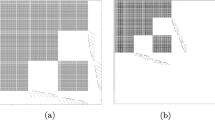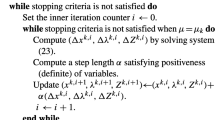Abstract
In this paper the step by step descent algorithm is extended to continuous optimization problems and applied to the optimal sizing of truss structures. The step by step descent method, recently developed, was applied to the discrete optimization of rigid structures. To solve continuous problems, a multi-stage optimization algorithm is proposed, which involves implementing the step by step descent method in multiple stages. In each stage, the continuous areas of the variables are progressively divided into a finite number of points. The algorithm is based on the search for the steepest gradient descent direction that minimizes the cost function and employs a wise heuristic approach to bypassing local optima. To evaluate the algorithm's performance, a study was carried out on ten mathematical and four truss optimization problems. For unconstrained mathematical problems, the algorithm demonstrates quick converges to optimum solution from any starting point. For truss structures, the starting design point is selected based on structural knowledge to enhance convergence speed. The obtained results surpass those achieved by other state-of-the-art optimization algorithms, affirming the efficiency, robustness and the promptness of the proposed method.










Similar content being viewed by others
References
Goldberg, D.E.: Genetic Algorithms in Search, Optimization and Machine Learning. Addison-Wesley Longman Publishing, Boston (1989)
Wu, S.J., Chow, P.T.: Genetic algorithms for nonlinear mixed discrete-integer optimization problems via meta-genetic parameter optimization. Engrg. Optim. 24, 137–159 (1995). https://doi.org/10.1080/03052159508941187
Wan, W., Birch, J.B.: An improved hybrid genetic algorithm with a new local search procedure. J. Appl. Math. (2013). https://doi.org/10.1155/2013/103591
Van Laarhoven, P.J.M., Aarts, E.H.L.: Simulated Annealing: Theory and Applications. Kluwer Academic Publishers, Dordrecht (1998)
Hasançebi, O., Erbatur, F.: On efficient use of simulated annealing in complex structural optimization problems. Acta Mech. 157, 27–50 (2002). https://doi.org/10.1007/bf01182153
Wang, Y.J.: Derivative-free simulated annealing and deflecting function technique for global optimization. J. Appl. Math. Comput. 26, 49–66 (2008). https://doi.org/10.1007/s12190-007-0010-7
Cenk, T., Serkan, S., Oguzhan, H.: Optimum design of steel lattice transmission line towers using simulated annealing and PLS-TOWER. Comput. Struct. 179, 75–94 (2017). https://doi.org/10.1016/j.compstruc.2016.10.017
Eberhart R.C., Kennedy J.: A new optimizer using particle swarm theory. In: Proceedings of the Sixth International Symposium on Micro Machine and Human Science, Nagoya, Japan, MHS’95. pp. 39–43 (1995)
Nezhad, A.M., Mahlooji, H.: A revised particle swarm optimization based discrete Lagrange multipliers method for non linear programming problems. Comput. Oper. Res. 38, 1164–1174 (2011). https://doi.org/10.1016/j.cor.2010.11.007
Lee, K.S., Geem, Z.W.: A new metaheuristic algorithm for continuous engineering optimization: harmony search theory and practice. Comput. Methods Appl. Mech. Energ. 194, 3902–3933 (2005). https://doi.org/10.1016/j.cma.2004.09.007
Cao, H., Chen, Y., Zhou, Y., Liu, S., Qin, S.: Comparative study of four penalty-free constraint-handling techniques in structural optimization using harmony search. Eng. Comput. 38, 561–581 (2022). https://doi.org/10.1007/s00366-020-01162-0
Wu, Z.Y., Li, D., Zhang, L.S.: Global descent methods for unconstrained global optimization. J. Glob. Optim. 50, 379–396 (2011). https://doi.org/10.1007/s10898-010-9587-8
Hansen, E., Walster, G.W.: Global Optimization Using Interval Analysis. Dekker, New York (2003)
Levy, A., Montalvo, A.: The tunneling algorithm for the global minimization of functions. SIAM J. Sci. Stat. Comput. 6, 15–29 (1985). https://doi.org/10.1137/0906002
Alexander, Y.G., Tatiana, S.Z.: Tunneling algorithm for solving nonconvex optimal control problems. Optim. Simul. Control (2013). https://doi.org/10.1007/978-1-4614-5131-0_18
El-Gindy, T.M., Salim, M.S., Ahmed, A.I.: A new filled function method applied to unconstrained global optimization. Appl. Math. Comput. 273, 1246–1256 (2016). https://doi.org/10.1016/j.amc.2015.08.091
Ge, R.P.: A filled function method for finding a global minimizer of a function of several variables. Math. Program. 46, 191–204 (1990). https://doi.org/10.1007/bf01585737
Zhang, Y., Xu, Y., Qiu, Q., He, X.: A filled function method for minimizing control variation in constrained discrete-time optimal control problems. J. Comput. Appl. Math. 326, 126–137 (2017). https://doi.org/10.1016/j.cam.2017.05.023
Bernal D., Ovalle D., Liñán D., Ricardez-Sandoval L., Gómez J., Grossmann I: Process superstructure optimization through discrete steepest descent optimization: a GDP analysis and applications in process intensification. In: Computer Aided Chemical Engineering (2022). https://doi.org/10.1016/B978-0-323-85159-6.50213-X
Liu, H., Wang, Y., Guan, S., Liu, X.: A new filled function method for unconstrained global optimization. Int. J. Comput. Math. 94, 1–14 (2017). https://doi.org/10.1080/00207160.2017.1283021
Dehghan, N.T., Shahzadeh Fazeli, S.A., Heydari, M.: A two-step improved Newton method to solve convex unconstrained optimization problems. J. Appl. Math. Comput. 62, 37–53 (2019). https://doi.org/10.1007/s12190-019-01272-z
Sellami, M.: Optimum design of planar steel frames under LRFD-AISC specifications using a step-by-step descent algorithm. Struct. Multidiscip. Optim. 65, 1–17 (2022). https://doi.org/10.1007/s00158-022-03264-3
Kaveh, A., Zaerreza, A.: Optimum design of the frame structures using the force method and three recently improved metaheuristic algorithms. Int. J. Optim. Civ. Eng. 13, 309–325 (2023)
Kaveh, A., Malakoutirad, S.: Hybrid genetic algorithm and particle swarm optimization for the force method-based simultaneous analysis and design. Iran. J. Sci. Technol. Trans. B Eng. 34, 15–34 (2010)
Kaveh, A.: Improved cycle bases for the flexibility analysis of structures. Comput. Methods Appl. Mech. Eng. 9, 267–272 (1976)
Ahmed, A.I.: A new filled function for global minimization and system of nonlinear equations. Optimization (2021). https://doi.org/10.1080/02331934.2021.1935936
Gao, Y., Yang, Y., You, M.: A new filled function method for global optimization. Appl. Math. Comput. 268, 685–695 (2015). https://doi.org/10.1016/j.amc.2015.06.090
Fatehi, M., Toloei, A., Niaki, S.T.A., Zio, E.: An advanced teaching-learning-based algorithm to solve unconstrained optimization problems. Intell. Syst. Appl. (2023). https://doi.org/10.1016/j.iswa.2022.200163
Noack, M.M., Funke, S.W.: Hybrid genetic deflated Newton method for global optimization. J. Comput. Appl. Math. 325, 97–112 (2017). https://doi.org/10.1016/j.cam.2017.04.047
Li, L.J., Huang, Z.B., Liu, F.: A heuristic particle swarm optimization method for truss structures with discrete variables. Comput. Struct. 87, 435–443 (2009). https://doi.org/10.1016/j.compstruc.2009.01.004
Zhang, Y.N., Liu, J.P., Liu, B., Zhu, C.Y., Li, Y.: Application of improved hybrid genetic algorithm to optimized design of architecture structures. J. South China Univ. Technol. 33, 69–72 (2003)
Sabour, M.H., Eskandar, H., Salehi, P.: Imperialist competitive ant colony algorithm for truss structures. World Appl. Sci. J. 12, 94–105 (2011)
Dede, T.: Application of teaching-learning-based-optimization algorithm for the discrete optimization of truss structures. KSCE J. Civ. Eng. 18, 1759–1767 (2014). https://doi.org/10.1007/s12205-014-0553-8
Cheng, M.Y., Prayogo, D., Wu, Y.W., Lukito, M.M.: A Hybrid Harmony Search algorithm for discrete sizing optimization of truss structure. Autom. Constr. 69, 21–33 (2016). https://doi.org/10.1016/j.autcon.2016.05.023
Soh, C.K., Yang, J.: Fuzzy controlled genetic algorithm search for shape optimization. J. Comput. Civil Eng. 10, 143–150 (1996)
Lee, K.S., Geem, Z.W.: A new structural optimization method based on the harmony search algorithm. Comput. Struct. 82, 781–798 (2004). https://doi.org/10.1016/j.compstruc.2004.01.002
Kaveh, A., Talatahari, S.: Particle swarm optimizer, ant colony strategy and harmony search scheme hybridized for optimization of truss structures. Comput. Struct. 87, 267–283 (2009). https://doi.org/10.1016/j.compstruc.2010.06.011
Kaveh, A., Khayatazad, M.: Ray optimization for size and shape optimization of truss structures. Comput. Struct. 117, 82–94 (2013). https://doi.org/10.1016/j.compstruc.2012.12.010
Kaveh, A., Mirzaei, B., Jafarvand, A.: An improved magnetic charged system search for optimization of truss structures with continuous and discrete variables. Appl. Soft Comput. 28, 400–410 (2015). https://doi.org/10.1016/j.asoc.2014.11.056
Kaveh, A.: Advances in Metaheuristic Algorithms for Optimal Design of Structures, 3rd edn. Springer International Publishing, Cham (2021)
Baghlani, A., Makiabadi, M.H., Maheri, M.R.: Sizing optimization of truss structures by an efficient constraint-handling strategy in TLBO. J. Comput. Civ. Eng. ASCE. (2017). https://doi.org/10.1061/(ASCE)CP.1943-5487.0000642
Kazemzadeh, A.S., Hasanc, O.: An elitist self-adaptive step-size search for structural design optimization. Appl. Soft Comput. 19, 226–235 (2014). https://doi.org/10.1016/j.asoc.2014.02.017
Kaveh, A., Dadras, A., Montazeran, A.H.: Chaotic enhanced colliding bodies algorithms for size optimization. Acta Mech. (2018). https://doi.org/10.1007/s00707-018-2149-8
American Institute of Steel Construction (AISC): Manual of Steel Construction-Allowable Stress Design. 9th ed., Chicago (1989)
Saka, M.P.: Optimum design of pin-jointed steel structures with practical applications. J. Struct. Eng. ASCE 116, 2599–2620 (1990). https://doi.org/10.1061/(ASCE)0733-9445(1990)116:10(2599)
Vanderplaats, G.N., Moses, F.: Structural optimization by methods of feasible directions. Comput. Struct. 3, 739–755 (1973). https://doi.org/10.1016/0045-7949(73)90055-2
Farshi, B., Ziazi, A.: Sizing optimization of truss structures by method of centers and force formulation. Int. J. Solids Struct. 47, 2508–2524 (2010). https://doi.org/10.1016/j.ijsolstr.2010.05.009
Najian Asl R., Aslani M., Panahi M.S.: Sizing Optimization of Truss Structures using a Hybridized Genetic Algorithm. arXiv preprint https://arxiv.org/abs/1306.1454 (2016).
Author information
Authors and Affiliations
Corresponding author
Additional information
Publisher's Note
Springer Nature remains neutral with regard to jurisdictional claims in published maps and institutional affiliations.
Appendix
Appendix
-
1. Two-dimensional Rastrigin function
\(\begin{gathered} {\text{min}}\;f\left( {x_{1} , \, x_{2} } \right)\, = \,x_{1}^{2} \, + \,x_{2}^{2} - cos(18x_{1} ) - cos(18x_{2} ) \hfill \\ s.t. - 2\, \le \,x_{i} \, \le \,2,\;i\, = \,1, \, 2. \hfill \\ f^{*} \, = \, - 2\;{\text{at }}\left( {0, \, 0} \right) \hfill \\ \end{gathered}\)
-
2. Two-dimensional Six-Hump Camel-back
\(\begin{gathered} {\text{min}}f\left( {x_{1} , \, x_{2} } \right)\, = \,{4}x_{1}^{{2}} - {2}.{1}x_{1}^{{4}} \, + \,x_{1}^{{6}} /{3}\, + \,x_{1} x_{2} - {4}x_{2}^{{2}} \, + \,{4}x_{2}^{{4}} \hfill \\ {\text{s}}.{\text{t}}. \, - {3}\, \le \,x_{i} \, \le \,{3},\;i\, = \,{1},{2}. \hfill \\ f^{*} \, = \, - {1}.0{\text{316284534 at }}\left( {0.0{898422}, \, - 0.{7126566}} \right){\text{ and }}( - 0.0{898422}, \, 0.{7126566}) \hfill \\ \end{gathered}\)
-
3. Treccani function
-
\(\begin{gathered} {\text{min}}\;f(x_{1} ,x_{2} )\, = \,x_{1}^{{4}} \, + \,{4}x_{1}^{{2}} \, + \,{4}x_{1}^{{2}} \, + \,x_{2}^{{2}} \hfill \\ {\text{s}}.{\text{t}}. \, - {3}\, \le \,x_{1} \, \le \,{3}\;{\text{and}}\, - \,{3}\, \le \,x_{2} \, \le \,{3}. \hfill \\ f^{*} \, = \,0{\text{ at }}\left( { - {2}, \, 0} \right){\text{ and }}(0,0) \hfill \\ \end{gathered}\)
-
4. Two-dimensional Shubert II function
min f(x1, x2) = \(\left(\sum_{i=1}^{5}i\mathrm{ cos}\left[\left(i + 1\right){\mathrm{x}}_{ 1}+ i \right]\right)\left(\sum_{i=1}^{5}i\mathrm{ cos}\left[\left(i + 1\right){\mathrm{x}}_{ 2} + i\right]\right)\)
s.t. 0 ≤ xi ≤ 10, i = 1, 2.
f* = − 186.730907998
-
5. n-dimensional Sine-square II function
min f(X) = \(\frac{\uppi }{\mathrm{n}}\Bigg\{10{\mathrm{sin}}^{2}\left(\pi {y}_{1}\right)+ {\left({y}_{n}- 1\right)}^{2}+{\sum }_{\mathrm{i}=1}^{\mathrm{n}-1}\Bigg[{({y}_{i} - 1)}^{2}(1 + 10{\mathrm{sin}}^{2}(\pi {y}_{i}+1)\Bigg]\Bigg\}\)
s.t. yi = 1 + (xi − 1)/4 and − 10 ≤ xi ≤ 10, i = 1, 2,..., n.
f* = 0 at xi.* = 1
-
6. n-dimensional Rastrigin function
min f(X) = 10n + \(\sum_{i=1}^{n}\left[{x}_{ i}^{2}-10 cos(2\pi {x}_{i})\right]\)
s.t. − 5.12 ≤ xi ≤ 5.12, i = 1,…,n..
f* = 0 at xi.* = 0
-
7. Branin function
min f (x1, x2) = (x2 − 1.275 x12/π2 + 5x1/π − 6)2 + 10(1 − 0.125/π) cos x1 + 10,
s.t. − 5 ≤ x1 ≤ 15, − 5 ≤ x2 ≤ 15.
f* = 0.397887 at (-π, 12.275), (π, 2.275) and (9.42478, 2.475),
-
8. Eason and Fenton’s gear train inertia function
min f (x1, x2) = \(\left\{12+{x}_{1}^{2}+ \frac{1+{x}_{2}^{2}}{{x}_{1}^{2}} + \frac{{x}_{1}^{2}{x}_{2}^{2}+100 }{{({x}_{1}{x}_{2})}^{4}}\right\}\left(\frac{1}{10}\right)\)
s.t. 0 < xi ≤ 10, i = 1, 2..
f* = 1.74 at (1.7435, 2.0297)
-
9. Wood function
min f(X) = 100(10x2 − x12)2 + (1 − x4)2 + 90(x4 − x32)2 + (1 − x3)2 + 10.1[(x2 − 1)2 + (x4 − 1)2] + 19.8(x2 − 1)(x4 − 1)
s.t. − 5 ≤ xi ≤ 5, i = 1,…, 4.
f* = 0 at xi* = 1
-
10. Ackley’s function
min f(X) = − 20 exp \(\left(\sqrt[-0.2]{\frac{1}{n}\sum_{i=1}^{n}{x}_{ i}^{2}}\right)\)-exp \(\left(\frac{1}{n}\sum_{i=1}^{n}cos(2\pi {x}_{i})\right)\)+20 + exp(1)
s.t. − 10 ≤ xi ≤ 10, i = 1, 2,..., n.f* = 0 at \({x}_{i}^{*}\)=0
Rights and permissions
Springer Nature or its licensor (e.g. a society or other partner) holds exclusive rights to this article under a publishing agreement with the author(s) or other rightsholder(s); author self-archiving of the accepted manuscript version of this article is solely governed by the terms of such publishing agreement and applicable law.
About this article
Cite this article
Sellami, M. A multi-stage descent algorithm for discrete and continuous optimization applied to truss structures optimal design. Acta Mech 234, 4837–4857 (2023). https://doi.org/10.1007/s00707-023-03630-2
Received:
Revised:
Accepted:
Published:
Issue Date:
DOI: https://doi.org/10.1007/s00707-023-03630-2




